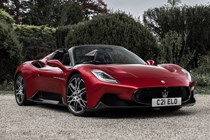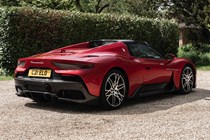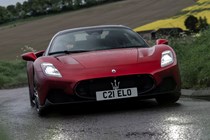
Maserati MC20 Cielo Spyder review
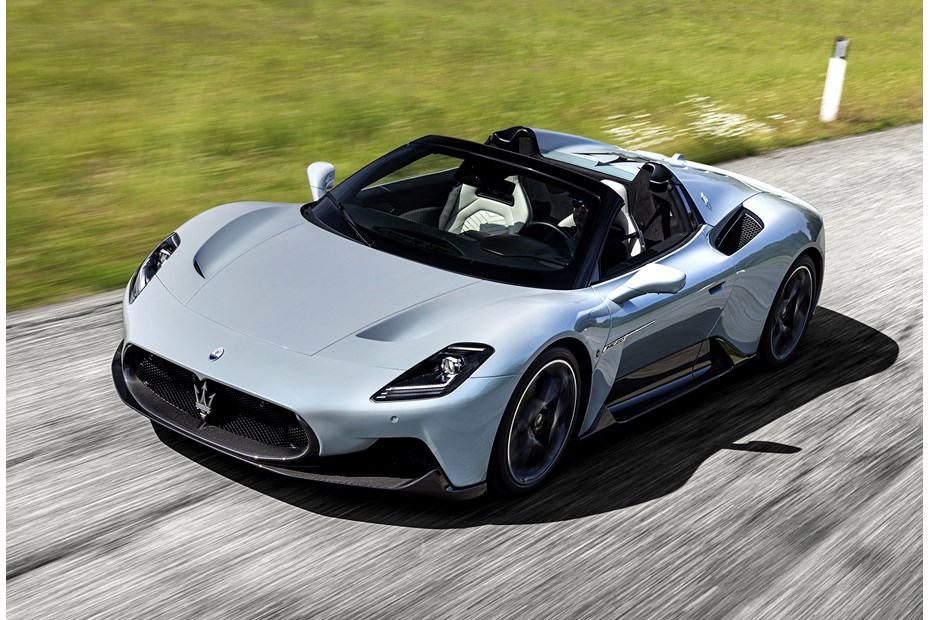
At a glance
| Price new | £252,755 - £288,995 |
|---|---|
| Road tax cost | £620 |
Get an insurance quote with

|
|
| Fuel economy | 24.1 mpg |
| Miles per pound | 3.5 |
| Number of doors | 2 |
| View full specs for a specific version | |
Available fuel types
Petrol
Pros & cons
- Surprisingly pliant suspension
- Rapid acceleration
- Communicative steering
- Fiat parts bin interior fittings
- Twitchy when pushed
- Could sound better
Overview
Think of the Maserati MC20 Cielo as the classy drop-top supercar. Where your bulls and horses are a bit, well, obvious, Maserati has long offered a slightly softer and more exclusive take on the sports car. It’s one that’s refreshingly free of hybridisation, although an all-electric MC20 Folgore is on the way.
Like the MC20 coupe, power is provided by a mid-mounted 630hp twin-turbo V6 that drives the rear wheels via an eight-speed dual-clutch gearbox. Adaptive dampers are standard and help change the car’s behaviour as you flick between drive modes using the prominent rotary dial.
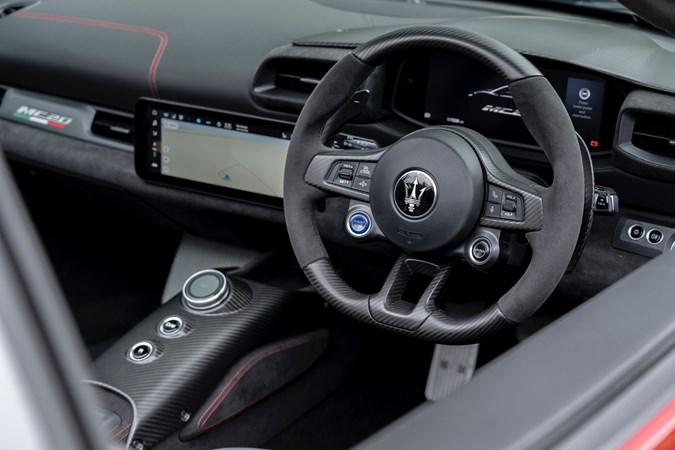
It gets from 0-62mph in 2.9-seconds, or the same as a Ferrari 296. It’s marginally quicker than the McLaren Artura, and simply destroys the admittedly cheaper Aston Martin DB12. There are even faster options out there like the McLaren 750S, but for most the MC20 Cielo will be fast enough.
What’s it like inside?
Think of it like a posh Alpine A110, and you’re not far off the mark. The seats are mounted quite close together in the centre of the car with not much centre console between you. You won’t be rubbing shoulders, but you might be clanging elbows on the narrow central armrest. There’s plenty of legroom and headroom isn’t bad at all thanks to the low-set seats.
The rest of the interior is pretty minimalistic, with most controls taken care of by a 10.25-inch touchscreen infotainment system. It’s responsive enough with clear graphics and logical menus, although some of the icons are small, it’s mounted a bit low, and we’d prefer physical roof controls, though. You get two boots, with the rear measuring less than a 100-litres and the front enough for a laptop bag at best.
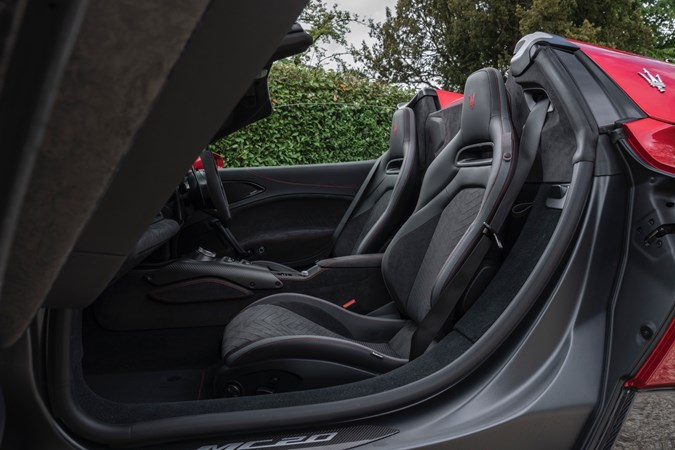
Those with larger car collections or a keen eye might notice the screen is shared with the Fiat 500e, with a few other controls lifted from Alfa Romeo, too. And while the materials are plush, there are some squeaks and areas that highlight that this is a hand built car.
Comfort
As you’d expect from something so potent, the seats are heavily bolstered buckets that grip you firmly in place. They receive more padding than the track focussed supercars out there, so longer trips won’t be a hardship unless you’re very generously proportioned. Electric adjustment makes finding an ideal driving position easy.

More of an issue is getting in and out. It’s easy enough with the roof off, but a bit of a pain with it in place. Not only is the roof low, there are also wide sills and the big seat bolsters to contort yourself past.
Safety
It’s very unlikely Euro NCAP will ever crash test such an expensive car, but the super-strong carbon fibre tub should keep you safe. You get airbags, ABS and stability control as standard, although most modern equipment is disappointingly left on the options list.
We’d recommend the Driver Assistance Package to gain pedestrian recognition for the automatic emergency braking, a surround view camera, blind spot monitoring, traffic sign recognition and heated, auto-dimming, power-folding door mirrors.
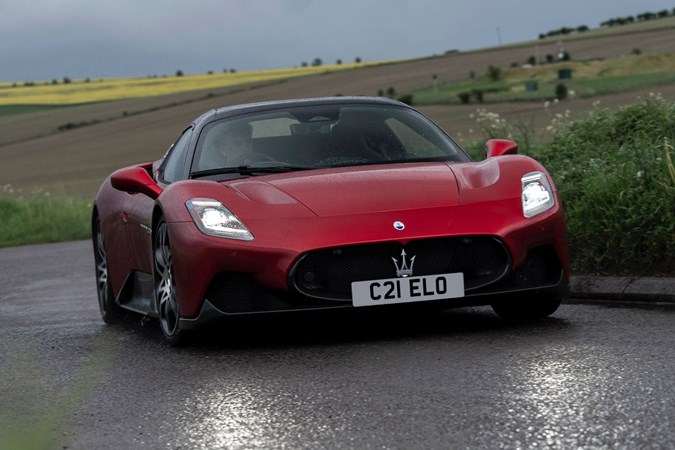
What’s it like to drive?
Perhaps the most surprising thing about the Cielo is how comfortable and easy to drive it is. The eight-speed dual-clutch automatic is smooth and unobtrusive, steering light and ride shockingly compliant. Leave the dampers in their softest setting and it’ll put some executive saloons to shame over most tarmac. This is not a car that you’ll need to avoid long journeys in.
Sport mode firms up the dampers and wakes up the gearbox, making it keener to let the engine spin past 3000rpm where it really starts making some power. Launch control helps it get from 0-62mph in 2.9-seconds but is only available in Corsa mode which disables the traction control. It’ll spin up the back tyres quite easily in the dry, so I’d recommend avoiding it altogether when it’s raining.
Unless you’ve become desensitised to speed thanks to the latest crop of super-EVs, you’ll find the MC20 feels mighty once the tyres have hooked up. The noise that accompanies the rampant horsepower isn’t the operatic howl you might hope for. Instead, there’s a gruff V6 overlaid with plenty of turbocharger whoosh and huff to go with a fair bit of road noise, too.
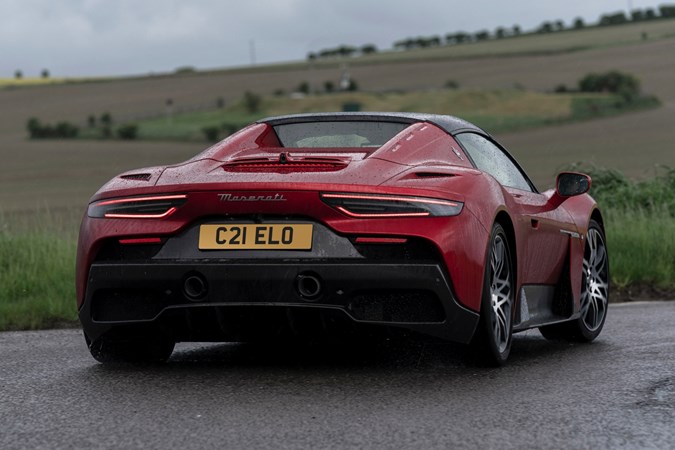
The steering relays a good amount of road feel and isn’t as hyperactive as some rivals. Grip levels are high, with gentle understeer if you push gently towards the limits. Heavier throttle inputs bring the tail into play, with the ESC stepping in quickly to quell things in all but Corsa mode. Here, you’ll get plenty of rope to hang yourself with.
Fold the roof and you’ve got the option of leaving the back window up to reduce buffeting, or you can leave it open for the full hurricane effect. With it up, it’s perfectly pleasant at motorway speeds but starts to get blustery beyond them.
What models and trims are available?
Once you’ve decided on an MC20 Cielo, you’re faced with a long list of options. We’d look carefully at this as some of the kit should really be standard on such a pricey car. This includes heated seats, a front suspension lift and some of the safety kit we mentioned. Add some carbon fibre and a few bits from the Fuoriserie list and you can add tens of thousands in options very quickly indeed.



